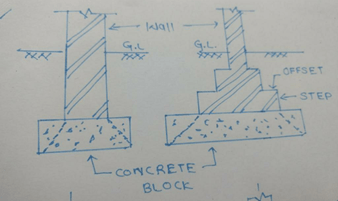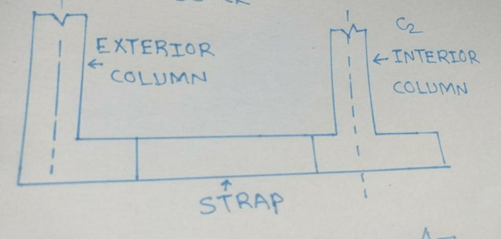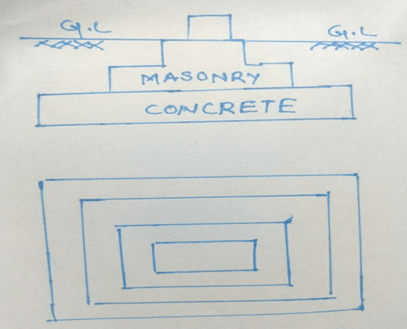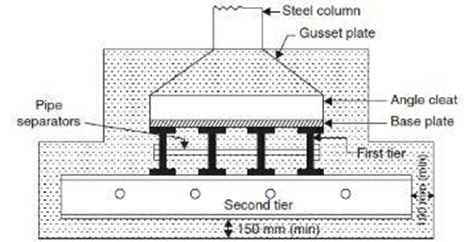This set of Construction and Building Materials Multiple Choice Questions & Answers (MCQs) focuses on “Foundations – Types of Footing”.
1. The formula d=a×√(3q)/m is used to calculate _________
a) Depth of soil
b) Height of column
c) Depth of concrete bed block
d) Height of footing
View Answer
Explanation: The depth of concrete bed block depends upon the type of concrete, the projection of block and the soil bearing pressure. It is found on the basis of the bending moment imposed on it, and on the basis of safe modulus of rupture. Here, d = depth of concrete block in metre, a = projection beyond the masonry face in centimetres, m = safe modulus of rupture of concrete mix, q = net soil bearing pressure.
2. If the wall or column under construction is near some other property, it will not be possible to spread the footing to both the sides of War or column. In search case which footing is used?
a) Simple pad footing
b) Eccentric footing
c) Isolated footing
d) Reinforced footing
View Answer
Explanation: Normally, the footing are so designed and proportion that the centre of gravity of the superimposed load coincides with the CG of the base area, so that the footing is subjected to concentric loading, resulting in uniform bearing pressure. However, it may not be possible to do so and hence eccentric loading footings are applied.
3. Identify the given footing below.

a) Strip footing
b) Combine footing
c) Reinforced footing
d) Isolated footing
View Answer
Explanation: A strip footing is the one that provides a continuous longitudinal bearing. Thus, a spread footing for a continuous wall is called a strip footing. The above given diagram shows two types of strip footings for a wall- i) Simple strip footing without masonry offset and
ii) Strip footing with masonry offset.
4. Identify the given footing below.

a) Continuous footing
b) Cantilever footing
c) Strip footing
d) Combine footing
View Answer
Explanation: A cantilever footing consist in an eccentric footing for the exterior column, the concentric footing for the interior column and a strap or a cantilever beam joining these two footing as shown in the given figure above.
5. Identify the given footing below.

a) Cantilever footing
b) Continuous footing
c) Strip footing
d) Pad footing
View Answer
Explanation: In this type of construction, the footings of two or three adjacent columns are made continuous by providing beans between the successive footings as shown in the above given figure. This type of construction is cheaper than raft foundations and it is adopted to avoid differential or uneven settlement of the structure.
6. Identify the given footing below.

a) Simple pad footing
b) Steeped footing
c) Strip footing
d) Stepped pad footing
View Answer
Explanation: If the column load is more, or if the safe bearing pressure of soil is less, the base area found by equation b+2a and hence there is a use of stepped pad footing instead of simple pad footing.
7. Identify the type of foundation below.

a) Wall footing
b) Combine footing
c) Grillage footing
d) Strap footing
View Answer
Explanation: The grillage Foundation is a special type of isolated footing, generally provided for heavily loaded steel, specially in those location where bearing capacity of soil is poor.
8. Which type of footing is applicable when the wall carries light loads or when the safe bearing pressure is very high?
a) Simple strip footing
b) Stepped footing
c) Simple pad footing
d) Eccentric footing
View Answer
Explanation: In this case, the width of the footing would be very low. In this type of footing, the wall directly rests on the concrete base and no masonry offset are provided since spread is not required.
9. The shape of combined footing is mostly ___________
a) Rectangular
b) Square
c) Circular
d) Trapezoidal
View Answer
Explanation: The shape of the combined footing should be so selected that the centres of gravity of the column loads of soil reaction remains in the same vertical line. Usually a rectangular or a trapezoidal shape is selected.
10. A spread footing for a single column is known as the __________
a) Isolated footing
b) Combine footing
c) Strip footing
d) Eccentric footing
View Answer
Explanation: A spread footing for a single column is either known as the isolated footing or pad footing. The base area of such a footing is given by A = P/q where P is the total load transmitted by the column, including that of the footing and q is the safe bearing pressure for the soil.
Sanfoundry Global Education & Learning Series – Construction and Building Materials.
To practice all areas of Construction and Building Materials, here is complete set of 1000+ Multiple Choice Questions and Answers.
If you find a mistake in question / option / answer, kindly take a screenshot and email to [email protected]
- Practice Civil Engineering MCQs
- Apply for Civil Engineering Internship
- Check Civil Engineering Books
- Check Construction and Building Materials Books
